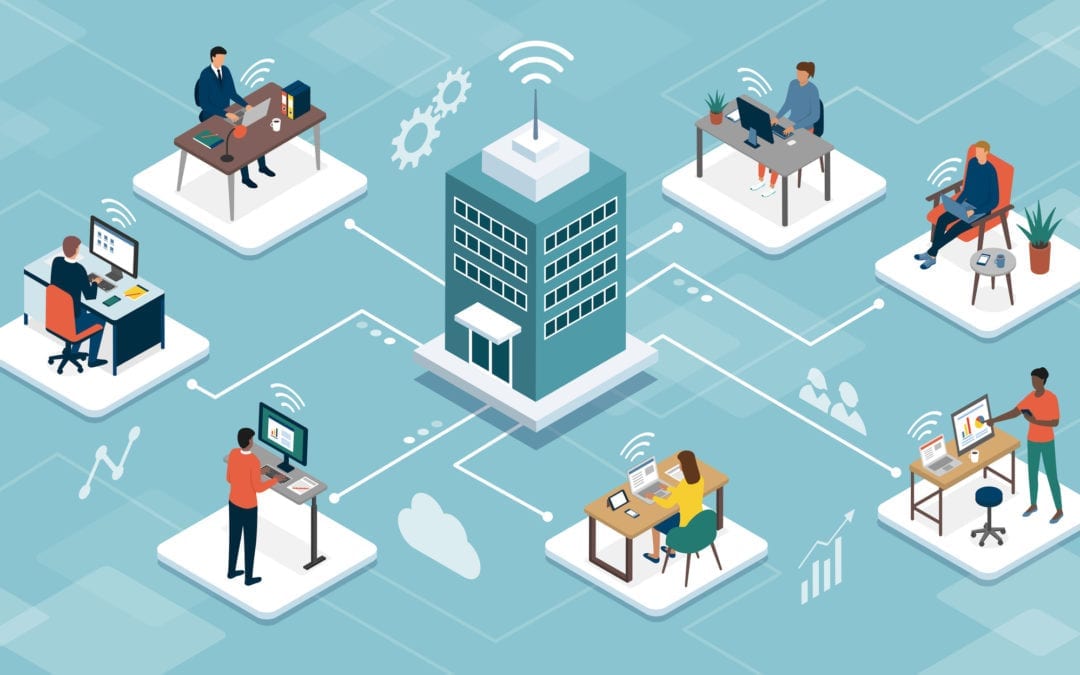In March 2020, the COVID-19 pandemic forced American businesses to adapt to completely new working conditions.
As quarantines and lockdowns were implemented, and businesses closed their office doors in an effort to avoid exposure to the virus, workers and companies alike scrambled to stay productive and keep the wheels turning.
Tens of millions of workers were compelled to shift from working in an office or other corporate location to working at home or splitting between the two. According to Gallup, 70% of Americans “always or sometimes” were working remotely by April 2020.
That kind of shift posed a huge challenge to companies’ existing IT infrastructures, as technology partners scrambled to facilitate a new working dynamic.
Today, with the advent of mass vaccinations, naturally-acquired immunity, and a lifting of lockdowns around the country, American businesses are finally feeling that it’s safe to get back to “normal” business operations.
Only problem is, the whole pandemic experience has seemingly pulled the rug out from under whatever “normal” is supposed to be. Shifts have occurred in the way companies and workers alike think about the on-site only work experience.
The Pandemic Has Had a Profound Impact on The Workplace Dynamic
Many companies have discovered that productivity can be maintained with a remote work force and that maybe expensive office real estate isn’t as necessary as they once thought it was.
On the other hand, other companies are anxious to get workers back to the office to resume traditional patterns of interaction, meetings, and staff management.
When it comes to the workforce, the pandemic experience has had a profound impact on how people think about when, where, and how they want to work. The disconnection from the daily routine of showing up to the office, and a recognition of the shortness of life a global healthcare crisis can bring, has many workers rethinking their careers and lifestyles. It’s caused many workers to re-evaluate the traditional go-to-the-office routine.
Many workers have found that the remote working life suits them well. They’ve grown to appreciate the flexibility, the control of their time, the easier childcare, and the ability to spend more time with their families. And, the escape from the drudgery of a daily commute and spending large chunks of time stuck on trains or in traffic have proven to be very appealing.
Some have even taken the remote working experience to the next level and tried to continue their careers while traveling, or touring the country in an RV with their family, or working from multiple different remote locations other than their homes.
A recent survey conducted by Morning Consult for Prudential polled 2,000 adults working full-time. It found that 87% of American workers who have been working remotely during the pandemic would prefer to continue working remotely at least one day a week, post-pandemic. Among all workers, 68% say a hybrid workplace model is best.
Interestingly, 42% of current remote workers say if their employer doesn’t continue to offer remote work options long-term, they’ll look for a job at a company that does. On top of that, the disruption caused by the pandemic has created a climate that has many feeling that now is a good time to re-examine their careers and consider pursuing other opportunities. Today, in fact, workers are quitting their jobs at the highest rates in 20 years.
A recent report by jobs site Monster.com said that 95% of workers are now considering changing jobs and 92% are willing to switch industries to find the right position. The employment field is currently very fertile. The labor Department is reporting a record 9.3 million jobs openings so many figure now is a good time to be looking.
A lot of workers, however, are more than ready to get back to the office. They’ve had their fill of the isolation of remote working and the sterility of Zoom meetings and Teams conferences. They’re anxious to get back to the workplace and interact with their co-workers again. Many believe that a common workplace is the best place for learning, mentoring, and advancement opportunities.
Adding to the mix is the lingering fear that the pandemic may not truly be behind us yet and we may still be vulnerable to a resurgence of this virus or the emergence of a new one.
The Best of Both Worlds?
So, what does the future workplace look like? Several companies, such as Microsoft, Google, and Apple say they will be using a hybrid model, whereby workers spend time both at the office and at home. In a recent survey 77% of business respondents say they will probably be pursuing such a hybrid model through this next year. 9 out of 10 organizations plan to be combining remote and on-site working, according to a separate McKinsey survey. Most companies, however, said they’ve haven’t hammered out the specifics of what that will look like.
Key among the challenges is how to facilitate the technology need of the new workplace. How to connect remote workers to the common network? How to accommodate workers with multiple devices and multiple points of access? How to ensure security over such a network? How to afford it?
Navigating the “New Normal” will no doubt be a delicate operation no matter what direction a company elects to take. What is done, how it’s done, and how technology systems adapt will define a company’s culture, and success, for years to come.

